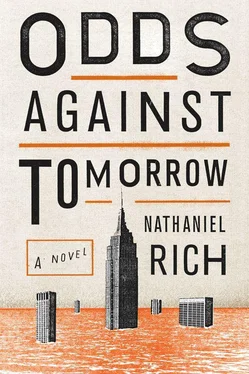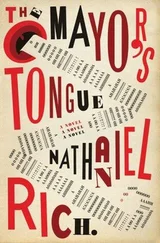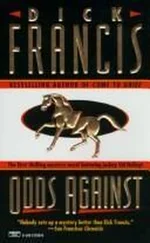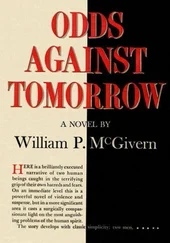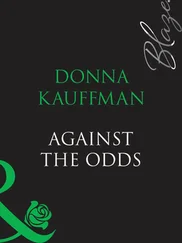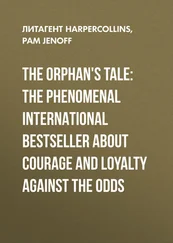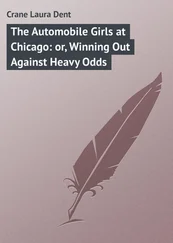* * *
Almost immediately after the encounter with Nybuster, Charnoble ceded control of client meetings to Mitchell. It was clear the kid had a special talent for conceiving cataclysmic scenarios.
“You’re like an exorcist in reverse,” Charnoble told him over the office intercom. Since their desks were at the far ends of their respective offices, Charnoble had to walk thirty-five feet to his door, step into the adjacent room, and then advance another thirty-five feet to Mitchell’s desk in order to have a face-to-face conversation. It became office policy to use the intercom instead, though Mitchell still jumped every time the reedy crackle of Charnoble’s voice disrupted the woolly silence of his vast empty chamber.
Mitchell pressed the intercom button.
“What do you mean, ‘an exorcist in reverse’?”
“Instead of warding off demons,” said Charnoble, “you summon them.” There was a pause, but since the static continued to emanate from the machine, Mitchell knew Charnoble was preparing another thought. “I think the word is ‘necromancer.’”
Mitchell pressed the intercom. “We really need to move to a different office,” he said.
“You don’t like the intercom system?”
“I don’t like being in the Empire State Building. It is not safe, and it is not good for business.”
“I agree, but Brumley won’t approve anything until our client list is larger.”
Mitchell pressed the intercom button, then removed his finger. He’d had enough of the intercom. It was making him feel as if he were delusional, hearing voices. He pushed himself away from his small desk, walked across the ivory carpet, and entered the foyer. Charnoble’s office door was closed. Mitchell knocked tentatively, but he was impatient to continue the conversation, and knowing that Charnoble was merely sitting at his desk across the room, he opened the door.
The room was empty.
9.
Mitchell began to spend most of his time at the library. He requested books on the engineering of New York skyscrapers, bridges, and highways. He found information that he could draft directly into his fear reports. He learned, for instance, that three-quarters of all city water lines had exceeded their design life, many by a century. The suspender bars that held up the Brooklyn Bridge had been snapping with alarming regularity since 2010. If the four ventilation fans on either end of the Holland Tunnel were to break down, drivers would die of carbon monoxide poisoning before reaching New Jersey. More violent crimes were committed in the Thirty-fourth Street BDFM subway station than in any other in New York. On the RFK Bridge there had for many years stood a sign that read IN EVENT OF AIR ATTACK, DRIVE OFF BRIDGE.
He examined so many topographical and geological maps of the city that the librarian informed him, in a hushed voice, that he had been added to an FBI watch list. He printed out stacks of reports prepared by international aid groups and government agencies. He started to think of them exclusively as acronyms: FEMA, USCG, NOAA, NYSOEM, DHS, ARC, DOT, DIA. He devised an acronym to remember all the acronyms: FUNNY DADDI. Yes, just like Tibor and his rib-tickling tales of the Hungarian pogroms.
Mitchell became gluttonous for information. The disaster research he’d done in college now seemed amateur, pathetically incomplete. He’d never had access to such resources before — an endless supply of industry and government reports, internal corporate records, and the use of proprietary software that Charnoble had imported from Brumley Sansome’s Risk department. But his greatest resource was time. For ten hours every day he was free to devour the raw data of disaster. The more he consumed, the more his appetite grew. The thousands of facts he ingested daily kept out Brugada, his parents, and the emptiness of his spooky, squalid orange-lit apartment. The facts were thrilling. Manhattan’s highest natural elevation was Bennett Park, an outcropping of schist in Washington Heights, 268 feet above sea level. Its lowest point was the Battery Park City Esplanade, seven feet above the Hudson River. A fault line ran across 125th Street and any day could trigger a magnitude 6 earthquake. Mitchell memorized the Richter scale and its equivalencies. An earthquake measuring 4.0 was equivalent to the detonation of a small atomic bomb; a 7.1 was as destructive as the largest thermonuclear weapon ever tested. About twenty 7.0s occurred annually, and one 8.0. The only thing in this world that could compare with the propulsive energy of an 8 or 9 earthquake was a previous 8 or 9 earthquake. In the great Panamanian quake of 1882, an 8.1, the force of the tremor broke some coastal homes in two. A young married couple, who slept on adjacent single mattresses, awoke to find themselves separated by a widening bay, their house split clean in half — she on the mainland, he on a tiny islet drifting away from her, into the sea.
Hurricanes were measured by the Saffir-Simpson scale, winds less than 118 mph by the Beaufort scale. Tornadoes were charted by the Fujita scale, named after Professor Tetsuya Fujita of Kitakyushu, Japan, a man known in press reports as “Mr. Tornado.” Through his work on tornado classification, Mr. Tornado discovered a peculiar meteorological phenomenon that he named a “microburst.” A microburst was a strong, localized air current that caused wind to change direction and speed rapidly. Mr. Tornado determined that this freakish phenomenon was responsible for most unsolved airline crashes. Mitchell had never heard of microbursts before and was terrified by the thought of them. The microburst, he decided, was Brugada’s meteorological equivalent: a small vector of chaos that could destroy life, unexpectedly, at any moment. For a long time he paused over the microbursts.
FEMA advised American citizens to keep in their homes, at all times, an emergency supply kit. This kit was to contain a wrench or pliers to disable utilities, a whistle, and a NOAA weather radio with tone alert. Books, games, and puzzles were also recommended. Disasters were like crime scenes: after the initial violence there was a lot of waiting around. If you kept yourself entertained, there was less opportunity for panic.
The new information crystallized in his brain. Wasn’t this the work he was born to do? His juvenile obsessions had prepared him well. He sometimes wondered whether he could remember details about emergencies more vividly than anecdotes from college or childhood. As he worked his mind opened up and he plowed himself into it. Brain ate heart. That’s not to say he was turning cold or emotionless — just the opposite. The bad news brought a rush of excitement; it fortified, too. It reached an intimate part of him. It didn’t merely feed his fears, it also fed his fascinations. The information had a way of seeping into his higher thoughts. After a while he began to feel that he was the information.
He went further afield, into doomsday prophecy and eschatology. It was tremendous fun. He read Nostradamus, Malthus, Alvin Toffler. He read Prophets and he read Revelation. Seven-headed dragons, locusts with man-faces wearing crowns of gold, a sea of glass mingled with fire — Mitchell loved Revelation. The Christians were excellent worst-case scenarists, even better than the Jews. They were terrified in Technicolor: green dragons, swirling orange fires of hell, scarlet demons.
During consultations his clients nervously swiveled in their ergonomic leather-padded office chairs as he guided them through scenes from Hell. It felt good to spread the darkness around. Misery liked company, but Misery loved a party festooned with rotting flowers, gaudy balloons inflated with cyanide gas, human piñatas.
Before long Mitchell had established a repertoire. With a new client he began by discussing Sino-American military conflict, and for the next several meetings he rounded out the war quartet with hour-long sessions on Iran/Israel, India/Pakistan, and the Koreas, war-gaming the rapid ascension to regional, then total nuclear war. Five thousand nukes were on active, hair-trigger alert all over the world, many aimed at financial centers. Even a “small,” regional nuclear war, such as Iran and Israel exchanging bombs, would kick up enough ash and particulate residue to dim the sun and cause global crop failure. A billion people would starve to death. Buried beneath the Ural Mountains, in the heart of Russia’s nuclear command and control system, there existed a doomsday device code-named PERIMETR. Though it was built during the Soviet era, it remained operational. Should Russian leadership be overthrown, a computer would automatically send launch orders throughout the country to nuclear missiles that would fire to all corners of the world. Half of mankind would be vaporized.
Читать дальше
